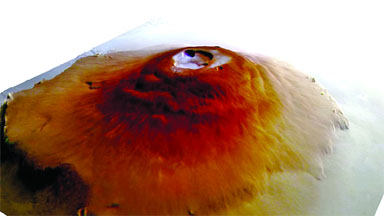In a surprising find that challenges previous beliefs about Mars’ climate, the European Space Agency’s spacecraft have detected water frost on the towering Tharsis volcanoes near the Red Planet’s equator – a region thought to be too warm for such frozen formations.
The frost was first spotted by ESA’s ExoMars Trace Gas Orbiter (TGO) atop the massive Olympus Mons volcano, which at nearly three times the height of Mount Everest is the tallest in the solar system. Subsequent observations by TGO’s NOMAD instrument and the Mars Express orbiter confirmed the unexpected presence of frost across multiple volcanoes in the Tharsis region.
“We thought it was impossible for frost to form around Mars’s equator, as the mix of sunshine and thin atmosphere keeps temperatures relatively high at both surface and mountaintop,” said lead researcher Adomas Valantinas of Brown University, who made the initial discovery during his PhD at the University of Bern.
Despite being incredibly thin – about one-hundredth of a millimeter or the width of a human hair – the frost patches cover vast areas within the volcanoes’ summit calderas. The amount represents a staggering 150,000 tonnes of water swapping between the surface and atmosphere each day during Mars’ cold seasons, equivalent to 60 Olympic-sized swimming pools.
The frost is present for just a few hours around sunrise before evaporating in the daylight. Its existence hints at “exceptional processes” creating a frost-friendly microclimate inside the deep volcanic calderas, according to the researchers.
“Winds travel up the slopes, bringing relatively moist air that condenses and settles as frost,” explained Nicolas Thomas of the University of Bern, principal investigator for TGO’s imaging system. “We see this on Earth and elsewhere on Mars causing clouds, but the frost appears to favor the shadowed, colder caldera regions.”
Water frost discovered on Mars’ tallest volcanoes for the first time

This simulated perspective oblique view shows Olympus Mons, the tallest volcano not only on Mars but in the entire Solar System. (Photo: ESA)